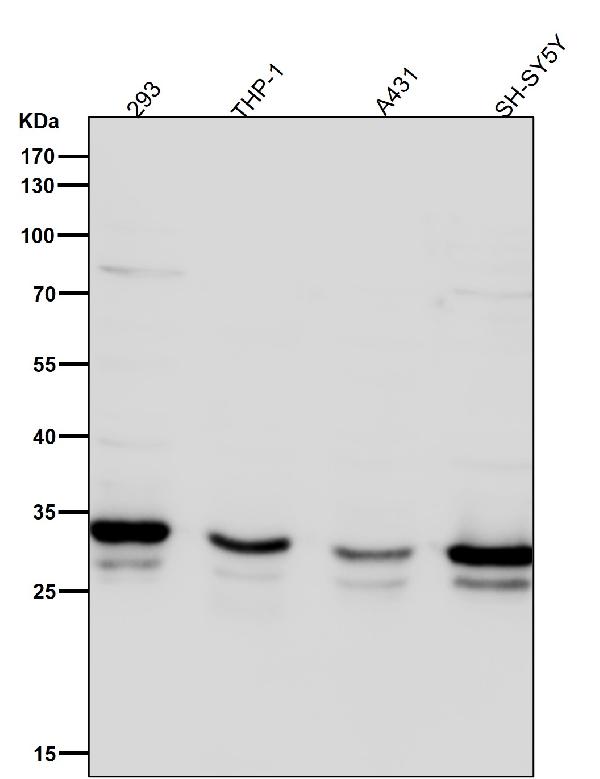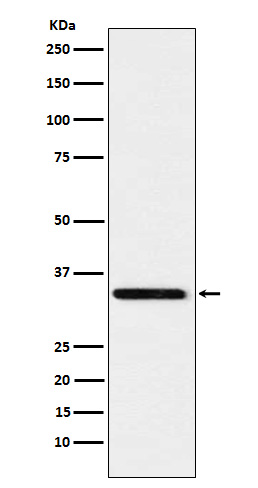Anti-Syntaxin 4 Rabbit Monoclonal Antibody
- SPECIFICATION
- CITATIONS
- PROTOCOLS
- BACKGROUND

Application
| WB |
|---|---|
| Primary Accession | Q12846 |
| Host | Rabbit |
| Isotype | IgG |
| Reactivity | Rat, Human, Mouse |
| Clonality | Monoclonal |
| Format | Liquid |
| Description | Anti-Syntaxin 4 Rabbit Monoclonal Antibody . Tested in WB application. This antibody reacts with Human, Mouse, Rat. |
| Gene ID | 6810 |
|---|---|
| Other Names | Syntaxin-4, Renal carcinoma antigen NY-REN-31, STX4, STX4A |
| Calculated MW | 34 kDa |
| Application Details | WB 1:500-1:2000 |
| Contents | Rabbit IgG in phosphate buffered saline, pH 7.4, 150mM NaCl, 0.02% sodium azide and 50% glycerol, 0.4-0.5mg/ml BSA. |
| Clone Names | Clone: 21S16 |
| Immunogen | A synthesized peptide derived from human Syntaxin 4 |
| Purification | Affinity-chromatography |
| Storage | Store at -20°C for one year. For short term storage and frequent use, store at 4°C for up to one month. Avoid repeated freeze-thaw cycles. |
| Name | STX4 |
|---|---|
| Synonyms | STX4A |
| Function | Plasma membrane t-SNARE that mediates docking of transport vesicles (By similarity). Necessary for the translocation of SLC2A4 from intracellular vesicles to the plasma membrane (By similarity). In neurons, recruited at neurite tips to membrane domains rich in the phospholipid 1-oleoyl-2-palmitoyl-PC (OPPC) which promotes neurite tip surface expression of the dopamine transporter SLC6A3/DAT by facilitating fusion of SLC6A3-containing transport vesicles with the plasma membrane (By similarity). Together with STXB3 and VAMP2, may also play a role in docking/fusion of intracellular GLUT4-containing vesicles with the cell surface in adipocytes and in docking of synaptic vesicles at presynaptic active zones (By similarity). Required for normal hearing (PubMed:36355422). |
| Cellular Location | Cell membrane {ECO:0000250|UniProtKB:Q08850}; Single-pass type IV membrane protein. Cell projection, neuron projection {ECO:0000250|UniProtKB:Q08850}. Cell projection, stereocilium {ECO:0000250|UniProtKB:P70452}. Note=Localizes to neurite tips in neuronal cells. {ECO:0000250|UniProtKB:Q08850} |
| Tissue Location | Expressed in neutrophils and neutrophil- differentiated HL-60 cells. Expression in neutrophils increases with differentiation. |

Thousands of laboratories across the world have published research that depended on the performance of antibodies from Abcepta to advance their research. Check out links to articles that cite our products in major peer-reviewed journals, organized by research category.
info@abcepta.com, and receive a free "I Love Antibodies" mug.
Provided below are standard protocols that you may find useful for product applications.
If you have used an Abcepta product and would like to share how it has performed, please click on the "Submit Review" button and provide the requested information. Our staff will examine and post your review and contact you if needed.
If you have any additional inquiries please email technical services at tech@abcepta.com.













 Foundational characteristics of cancer include proliferation, angiogenesis, migration, evasion of apoptosis, and cellular immortality. Find key markers for these cellular processes and antibodies to detect them.
Foundational characteristics of cancer include proliferation, angiogenesis, migration, evasion of apoptosis, and cellular immortality. Find key markers for these cellular processes and antibodies to detect them. The SUMOplot™ Analysis Program predicts and scores sumoylation sites in your protein. SUMOylation is a post-translational modification involved in various cellular processes, such as nuclear-cytosolic transport, transcriptional regulation, apoptosis, protein stability, response to stress, and progression through the cell cycle.
The SUMOplot™ Analysis Program predicts and scores sumoylation sites in your protein. SUMOylation is a post-translational modification involved in various cellular processes, such as nuclear-cytosolic transport, transcriptional regulation, apoptosis, protein stability, response to stress, and progression through the cell cycle. The Autophagy Receptor Motif Plotter predicts and scores autophagy receptor binding sites in your protein. Identifying proteins connected to this pathway is critical to understanding the role of autophagy in physiological as well as pathological processes such as development, differentiation, neurodegenerative diseases, stress, infection, and cancer.
The Autophagy Receptor Motif Plotter predicts and scores autophagy receptor binding sites in your protein. Identifying proteins connected to this pathway is critical to understanding the role of autophagy in physiological as well as pathological processes such as development, differentiation, neurodegenerative diseases, stress, infection, and cancer.




